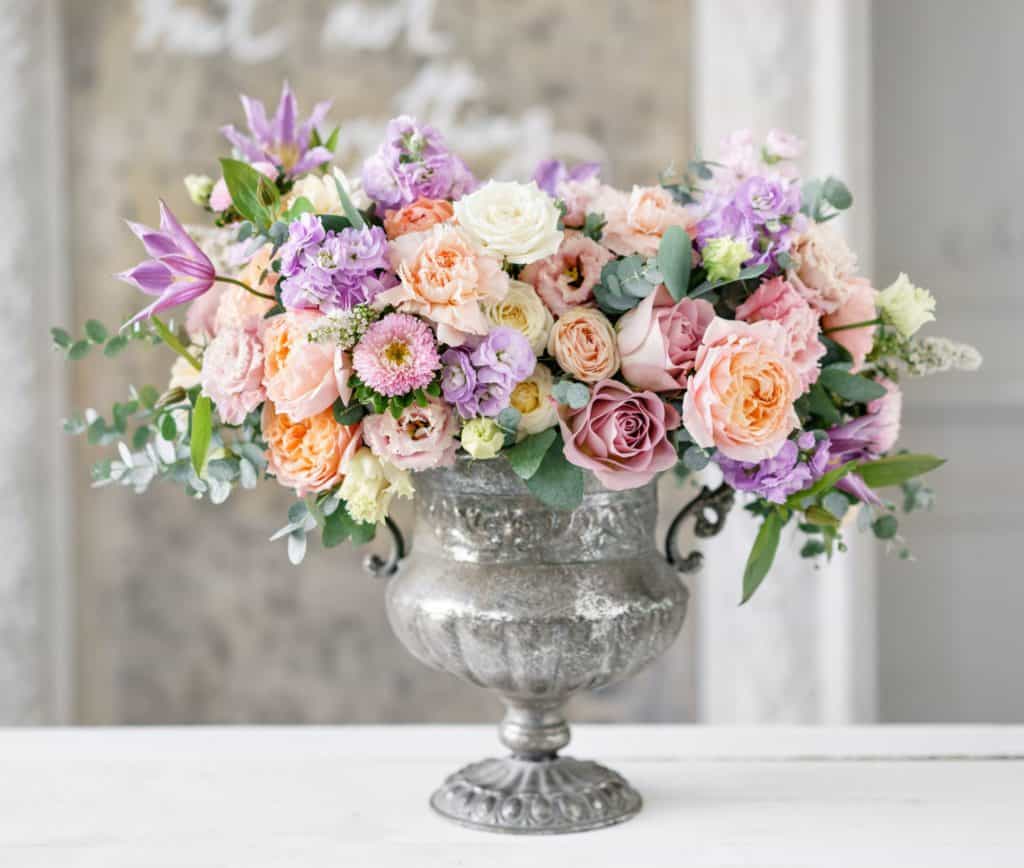
Types of Flowers Used in Floral Arrangements – Focals, Fillers, Line Flowers, and Greenery
A lot goes into creating a gorgeous arrangement of fresh flowers. With an endless number of possible floral combinations and hundreds of flower varieties to choose from, it’s important to know the essential “building blocks” of floral design. These building blocks encompass all flower varieties broken down into 4 categories: focal flowers, filler flowers, line flowers, and greenery.
Each of the four types of flowers has a particular role to play and is an essential component in designing a balanced, lush, and visually appealing floral arrangement. Focal flowers draw one’s eye in, line flowers add height and vertical elements, filler flowers fill in the gaps, and greenery complements and bolsters the entire bouquet. Recognizing these different flower types, understanding the various roles they play, and how they work together is key to creating jaw-dropping, fabulous flower arrangements.

Types of Flowers You Need to Create a Beautiful Bouquet
What Are Focal Flowers?
Focal flowers are blooms that immediately attract your eye due to their size, color, or attractive features. These florals are the stars of the show and typically consist of a large bloom on a single stem. Having a selection of one to four focal flowers in your arrangement is a good rule of thumb to go by.
Popular Focal Flowers:
What Are Line Flowers?
Line flowers have multiple clusters of blooms that grow along a tall stem. They add height, shape, and vertical elements to a bouquet. Line flowers create the “setting” or framework and stretch the arrangement into its surrounding space. Line flowers create a shape that can be structured, closed, symmetrical, asymmetrical, or open. In contrast to focal flowers, which give your eye a place to rest, line flowers create rhythmic and flowing movement throughout the bouquet, which pulls all the parts into a cohesive, beautiful composition.
Popular Line Flowers
What Are Filler Flowers?
Filler flowers fill in the gaps and make arrangements look full, lush, and complete. Typically, filler flowers are smaller than focal flowers, with clusters of blooms that provide volume, texture, variety, and different colors to the overall floral design. Often playing the role of “supporting cast” to the larger, focal flowers, filler flowers can be just as striking, breathtaking, and mood-setting as any rose, peony, or dahlia. Filler flowers can help you set the tone for the effect you’re trying to evoke, such as dramatic, traditional, sweet, passionate, or cheery.
Popular Filler Flowers
How Is Greenery Used in Bouquets?
Greenery is an essential part of floral arrangements as it completes the overall look giving the bouquet a lush, healthy boost of overflowing greenery to support the colorful blooms. Not only does greenery add texture and movement, but it also complements the vibrant hues of the flowers, gives the eye a place to rest, adds interest and variety, and can make a statement all its own.
Popular Types of Greenery
Breaking Down a Floral Bouquet – Focals, Fillers, Line, and Greenery
Designing a floral arrangement is all about creating balance and contrast, movement and pauses, drama and tranquility to express your own unique floral story. Now that you know the types of flowers to use and their roles, you can begin creating a symphony of gorgeous bouquets. It’s best to start by selecting one to four focal blooms, the greenery you want to use, and then choose which line flowers and filler flowers will add the final touches and bring your vision to life. The bouquet below is a good example of how the four different flower types work together to create a beautiful final product.
Focal flowers: Dahlias and Garden Roses
Line Flowers: Blue Thistle and Celosia
Filler Flowers: Alstromeria and Baby’s Breath
Greenery: Myrtle and Eucalyptus

